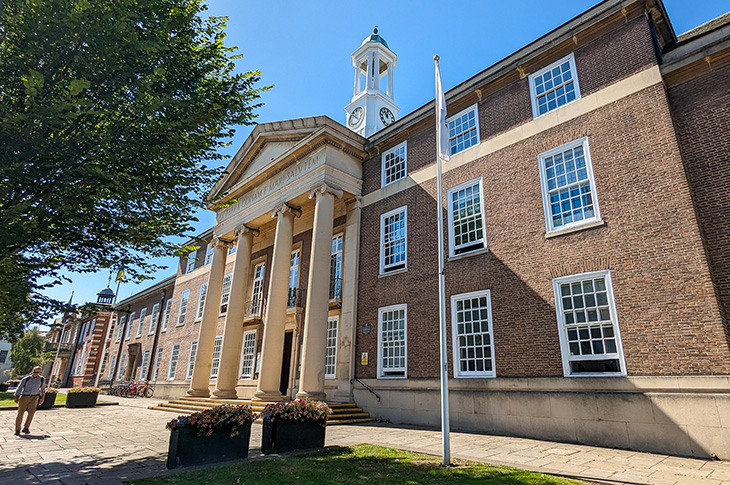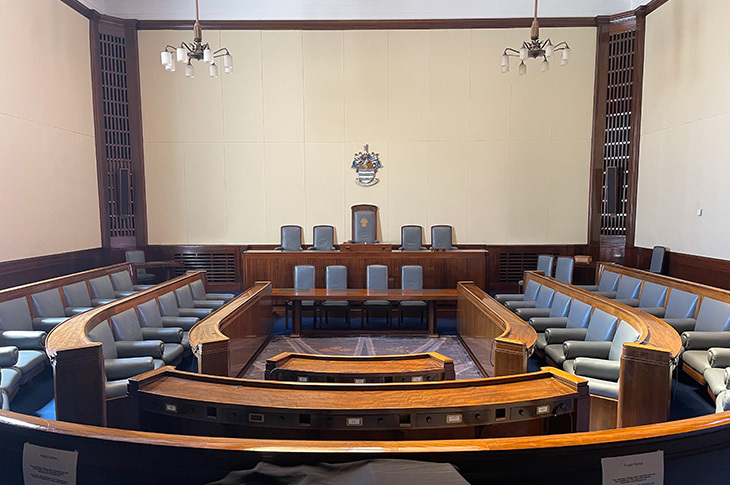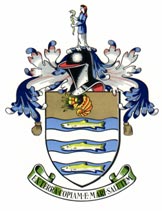History of Worthing Town Hall, the Mayoralty and Civic Insignia
See also:
Worthing Town Hall
The Town Hall was opened on 22nd May 1933 by the then Prince George and replaced the old Town Hall in South Street.
In March 1930 the Council had invited competitive designs for a new building. The winner, chosen from 48 entries was Charles Cowles-Voysey, a London architect. (See also Charles Cowles-Voysey on Wikipedia).
Work commenced on 1st October 1931 and was completed on 31st March 1933 exactly on schedule. As a condition of Government grant being given towards the cost of the works, 90% of the workforce was taken from the unemployed.

Opening of the Town Hall
The official opening of the building was a lavish affair, with guards of honour, military processions, dances and fireworks.
The cost of the Town Hall building was £398,117 with £11,771 spent on furniture. This represented a saving of £1,322 on the original estimate.
The insurance value today of the Town Hall and its contents is in excess of £29m.
The Council Chamber
Is where the Full Council - all 37 members - sits to receive reports and recommendations from the Cabinet and Committees.
The Mayor chairs the meeting. He/she has a casting vote in the event of an equality of votes.
For the present make-up of Worthing Council see the Worthing Councillors webpage.
The carpet in the central well of the Council Chamber is the original from when the building was opened.
It is understood that the architect, Charles Cowles-Voysey, had hoped for a plaque to be erected outside the building to acknowledge his work. For reasons unknown the Councillors at the time did not agree and by way of compromise, his name is spelt out randomly in the carpet.

The Mayor
The Mayor:
- Is elected by his/her fellow Councillors each May, following the local elections
- The Mayor serves for the Municipal Year which runs from May to May
- He/she is non-political during the year of office
- The Mayor takes precedence over everyone in the Borough except members of the Royal Family or their representatives
- The title of 'Mayor' applies to males or females
- If the Mayor is male he will have a Mayoress
- If the Mayor is female she will have a Mayor's Consort
Names on the wall
The names of all the past Mayors of Worthing are engraved on the walls outside the Council Chamber and Committee Suite.
Worthing is entitled to have a Mayor because it has borough status which was originally conferred by HM Queen Victoria in 1890.
When local government was re-organised in 1974, that status was re-conferred by HM Queen Elizabeth II.
Neighbouring authorities Adur and Arun are District Councils with a Chairman.
See also:
Borough Arms (or coat of arms)
 When Borough status was first granted in 1890, Mr T R Hyde was asked to produce a design for the Borough Arms (or coat of arms, or armorial bearings) and his design was adopted by the Council.
When Borough status was first granted in 1890, Mr T R Hyde was asked to produce a design for the Borough Arms (or coat of arms, or armorial bearings) and his design was adopted by the Council.
Steps were not taken to obtain an official grant of the Arms from the College of Arms until 1918 (after prompting by the College) and the Borough Arms and crest were formally granted by Letters Patent dated 30th October 1919.
The Latin Motto depicted on the Crest translates as:
"From the land fullness and from the sea health".
The figure on the crest is technically Hygieia. In Greek mythology, Hygieia was a daughter of Asclepius. She was the Goddess of health, cleanliness and sanitation. She was often depicted as a young woman feeding a large snake that was wrapped around her body. Her name is the source of the word 'hygiene'.
The coat of arms of Worthing includes three fishes, a Horn of Plenty overflowing with corn and fruit on a cloth of gold, and the figure of Hygieia, the Goddess of Health holding a snake. They represent the health given from the seas, the fullness and riches gained from the earth and the power of healing.
The original reason for founding the town was as a health resort for Princess Amelia, the daughter of HM King George III, to take the sea air to recover her health following illness. It was probably adopted on the crest as a homage to her therefore (so it is Amelia in spirit) as well as promoting the town's aspirations to be viewed as a health resort.
Before that, Worthing was just a fishing village, but after her visit the place became fashionable and was used as a health resort by prominent people.
Royal Charters
Borough status was granted for Worthing on 15th August 1890 by HM Queen Victoria:
The Granting of Arms dated 30th October 1919 by HM King George V permits the Armorial Bearings:
The new Charter was conferred by HM The Queen after the Local Government reorganisation in 1974:
Mayor's Robe
The scarlet Mayor's robe, which was worn for special civic occasions, is edged with Russian sable fur and is worn with white gloves, lace cuffs and a lace jabot (ruffle).
The Mayor's Chain
Is made of 24-carat gold and weighs 32ozs. It was bought in 1891 - funded by public subscription.
The coats of arms on the chain are those of the de Warennes, the Dukes of Norfolk, Viscount Hampden, Earl de la Warr, Thomas A'Becket and the Archbishop of Canterbury.
The Chain is the symbol of authority to carry out Mayoral duties and is only worn on certain occasions.
Mayor's badge of office
On other occasions the Mayor wears the badge of office - this is made of 9-carat gold and enamel and is elaborately designed with scrolls, crossed mace and shields, rosettes and the figure of a lady thought to be Princess Amelia.
The Mace
The silver gilt mace is the symbol of the current King's authority to carry out business at Council meetings and the Macebearer carries the mace, with the heavy end up in front of the Mayor. If the monarch comes to Worthing the mace is carried with the heavy end downwards symbolising the authority is with the monarch. The mace was funded by public subscription in 1891.
The mace was originally a weapon of war, made of wood and then iron and steel with spikes fitted onto the ball. In the 12th Century it became a form of protection for the Monarch from assassins. In Tudor times the mace became the ornamental symbol we know today. It weighs 10kg (or 22lbs).
Mayor's Parlour
The Mayor's room or office is known as the 'Parlour' (from the French 'parler' to speak.) The Mayor will receive visitors in the Parlour on many social occasions.
Map of Worthing
The map of Worthing in the parlour was painted in 1933 by McDonald Gill, brother of Eric Gill, the famous illustrator.
It depicts Worthing in 1933. At that time there was no development in Findon Valley or West Durrington and very little in Goring. There were however many glasshouses producing figs, tomatoes, grapes, cucumbers, mushrooms and chrysanthemums.
Mayoress
The Mayoress plays a very important role in supporting the Mayor. She usually attends each function with the Mayor.
Engagements
Mayors carry out, on average 400 engagements a year, excluding attendance at Council meetings.
Most of those engagements are of a 'social' nature, for example attending dinners, lunches, charity fairs, opening events, visiting centenarians, schools, churches, presenting prizes and awards, Rotary Festival, Worthing Lions Summer Festival, Worthing Festival, club AGMs, charity events, promoting economic development in town, business breakfasts, thank you parties etc.
To book the Mayoral engagements.
Honorary Aldermen
Honorary Aldermen are former Mayors who have retired from the Council. They do not participate in Council business but are invited to attend civic events.
You can find out about them on our:
Chaplain / Spiritual Leader
Each year the Mayor chooses a Chaplain or a Spiritual Leader from a church or religious establishment of his or her choice. The Chaplain / Spiritual Leader is invited to attend all Council meetings, starting the proceedings with prayers as agreed by the Mayor.
Overview of events
- The first meeting of the new Borough Council was held on 10th November 1890 when Alfred Cortis was elected as the town's first Mayor.
- The fledgling administration was faced with a disastrous beginning - an outbreak of typhoid in the summer of 1893 (caused largely as a result of insanitary conditions) caused the death of almost 200 people - roughly one person in every seventy of the population at that time.
- The Council was forced to take drastic action and in 1895 there was a dramatic improvement in the town's drainage system.
- During the Second World War the Town Hall was the centre of the town's war effort - distributing nearly 60,000 gas masks, 168,000 sandbags, removing major artefacts from the Library and Museum to places of safety.
- The then Town Clerk was billeting Officer for some 12,000 evacuees from London.
- One of the town's first casualties of the War was a corporation horse called Colonel. He was hit in the ear by a piece of shrapnel but returned to work after treatment.
- The earliest records of Worthing date back to 1803 when a special Act of Parliament was passed, "for the Government of the Town of Worthing and for establishing an effective police force."
- A governing body of 72 commissioners was set up as the local authority.
- At that date the area of the town was only 784 acres.
- In 1852 the Town Commissioners were superseded by a Local Board consisting of 15 members.
- In 1865 West Worthing was a separate town, with an independent local authority. It was not until 1890 that the old town and West Worthing were amalgamated and incorporated by 'Royal Charter as the Borough of Worthing'.
- In 1902 the borough boundaries were extended by the inclusion of a large part of the parishes of Broadwater and West Tarring.
- In 1929 the borough was extended again, taking in the whole of the parishes of Durrington and Goring by Sea.
- In 1933 the parishes of Findon and Sompting were added.

Need assistance with this service?
Get in touch:
Worthing Civic Office
Page last updated: 25 March 2024



 Please send us an email (we will aim to reply within 14 working days)
Please send us an email (we will aim to reply within 14 working days)
